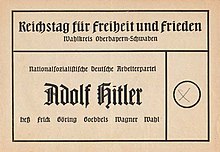Reichstag election in the German Reich 1936

The Reichstag election of March 29, 1936 took place at the same time as the subsequent referendum on the authorization to occupy the Rhineland . As in the November 1933 election, only one NSDAP unified list was permitted . It was therefore a sham election , as the result was already clear from the start: the election and the vote (as intended by the Nazi regime ) resulted in clear approval.
After the Saar referendum on January 13, 1935, the Saarlanders were called for an all-German election for the first time since 1919 . By contrast, the Reich Citizenship Act of September 15, 1935, meant that Jews had lost their right to vote; for the first time, like so-called Jewish half-breeds , they were not allowed to vote in a Reichstag election.
Results
The NSDAP's list officially received 98.8% of the votes, including all blank ballot papers. 1.2% of the votes cast were z. B. due to deviating markings on the ballot as invalid.
As already determined during the Weimar Republic , there was one seat for every 60,000 votes cast , which is why 741 of the nominees on the unified list moved into the Reichstag . 722 were members of the NSDAP, 19 were non - party designated as guests . There were no women among the MPs.
The official turnout was 99 percent.
The almost unanimous result with which the electorate approved the Nazi regime can be partly explained by the monopoly of the NSDAP, which was the only party allowed in the German Reich since the law against the formation of new parties . In addition, there were probably also election fraud . According to the historian Henning Köhler , the mass approval of National Socialism and the Führer cult , "which also bore traits of religious veneration," were very significant. The fact that the election result can still be seen as “real” to a large extent is indicated by the slight difference to the Saar vote, in which, under democratic conditions, 90.73% of those eligible to vote in January 1935 voted for affiliation with the Nazi state.
See also
- List of members of the Reichstag under National Socialism (3rd electoral term)
- Right to vote in the time of National Socialism
literature
- Gerhard Schulz : Germany since the First World War 1918–1945 , Vandenhoeck & Ruprecht , 2nd edition, Göttingen 1982, pp. 144–145, ISBN 978-3-52533-472-0 .
- Heinrich August Winkler : The long way to the west , vol. 2, CH Beck , Bonn 2005, p. 32f, ISBN 978-3-406-49527-4 .
- Marcel Stepanek : Election campaign under the sign of dictatorship. The staging of elections and votes in National Socialist Germany , Leipziger Universitätsverlag , Leipzig 2014, ISBN 978-3-86583-898-8 .
Web links
- Frank Omland: Elections 1933 to 1938: "You are voting for me nich Hitler!" (Example Schleswig-Holstein)
Individual evidence
- ^ Hans-Joachim Heinz: The electorate under the swastika. In: Series of publications on the history of the city of Germersheim , Volume II, Germersheim 2001, ISSN 1618-9663 , pp. 192-204.
- ↑ a b newspaper witnesses , # 15/2012, p. 3.
- ^ Reichstag handbooks , 1936: Directory of the members of the Reichstag. Bavarian State Library , accessed on September 6, 2012 .
- ↑ Stepanek, p. 123.
- ^ Henning Köhler : Germany on the way to itself. A history of the century . Hohenheim-Verlag, Stuttgart 2002, p. 392.
